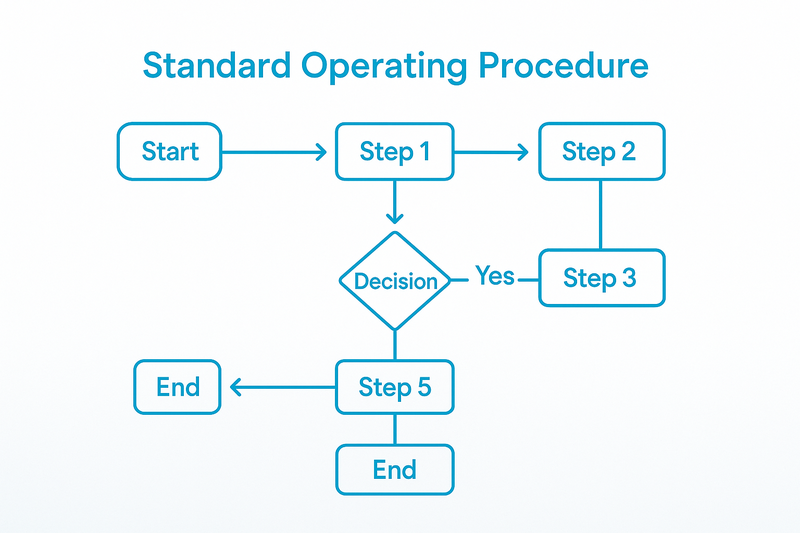How often should SOPs be reviewed and updated?
If you're running a business, you've probably created some Standard Operating Procedures (SOPs), or at least thought about it (if not, you should definitely have a look at our guide to SOPs).
Maybe you documented your key processes when you were trying to scale, or perhaps you wrote them down when training became too time-consuming. But here's the question that stumps most business owners and that we get asked all the time: how often should you actually review and update these procedures?
This is a valid question, and one of the main pain points for most businesses when they approach SOP and process documentation. The reason behind the question, is that often times SOPs and business workflows end up becoming outdated and therefore not useful as they used to be.
The answer to the question isn't as straightforward as "every six months" or "once a year." It depends on your business, your industry, and how fast things change around you. But here's what every business owner needs to know: ignoring SOP maintenance is costing you money, efficiency, and possibly putting you at risk.
As a rule of thumb, most small businesses should review their critical SOPs every 6-12 months, with quarterly checks for high-risk or rapidly changing processes. The key is creating a simple system that doesn't overwhelm your team but keeps your business running smoothly.
Why SOP reviews actually matter for your business

A lot of business owners see SOP reviews as just another administrative task. Something you do when you have extra time (which you rarely have!). But here's what's really happening when you let your procedures get stale:
- Your team starts making it up as they go. Without updated procedures, employees fill in the gaps with their own interpretations. What starts as small variations becomes major inconsistencies. Your customer experience becomes unpredictable, quality suffers, and training new people becomes a nightmare.
- You're losing real money through inefficiency. For a small business, even a 10% efficiency loss can translate to thousands of dollars in wasted time, rework, and missed opportunities. Without updated procedures for your core business tasks, you are literally leaving money on the table.
- You're creating unnecessary business risk. Outdated safety procedures can lead to accidents. Old compliance processes can trigger audits or fines. Even small regulatory changes can have big consequences if your SOPs don't reflect current requirements.
- Knowledge walks out the door. If your SOPs aren't up to date, you're essentially gambling that your key people will never quit, get sick, or take vacation. When they do, you will lose a considerable amount of time trying to back track how to do things or what the latest process is. And we all know... time is money too!
Think about it this way: would you drive a car without ever changing the oil? Your SOPs are the oil that keeps your business engine running smoothly. Neglect them long enough, and things start breaking down.
The real cost of letting SOPs go stale
Here's what business owners don't realize: the cost of maintaining SOPs is tiny compared to the cost of not maintaining them. Let's break down what outdated procedures actually cost your business:
- Time drain on your team. When procedures are unclear or outdated, employees spend hours figuring out what to do. We are talking about hours and hours of productivity lost every week, with employees doing nothing but looking for answers.
- Training becomes a nightmare. Without up-to-date SOPs, training new hires becomes a time-consuming, inconsistent process. If you're paying a manager $30/hour to train someone for an extra 20 hours because procedures are unclear, that's $600 per new hire in unnecessary costs (by the way, have you checked our cutting-edge Path feature that puts onboarding on autopilot?)
- Quality issues multiply. When everyone's doing things slightly differently, quality becomes unpredictable. Customer complaints increase, returns go up, and your reputation takes a hit. Businesses with up-to-date procedure see a drastic reduction of errors and defects. That's a dramatic improvement that directly impacts the bottom line.
- Compliance risks get expensive. Depending on your industry, outdated procedures can trigger fines, audits, or legal issues. Even service businesses need to stay current with data protection, employment law, and industry-specific regulations.
- You can't scale effectively. This is probably the one that goes under the radar the most for business owners. When procedures are unclear or outdated, growing your business becomes much harder. You can't confidently delegate, can't maintain quality across locations, and can't quickly onboard the staff you need to expand.
How often should you actually review your SOPs?

The frequency of SOP reviews isn't one-size-fits-all, but here's a practical framework that works for most businesses:
Every 6-12 months: your core business SOPs
These are the procedures that directly impact your customers, revenue, or core operations. Think customer service protocols, quality control processes, sales procedures, and key operational workflows. Most organizations should conduct annual or biannual reviews for these critical processes.
Every 3-6 months: high-risk or regulated processes
If you handle sensitive data, work in a regulated industry, or have procedures that could impact safety, these need more frequent attention. Financial processes, safety protocols, and compliance procedures should be checked quarterly or even monthly in rapidly changing environments.
Every 1-2 years: administrative and support SOPs
Back-office procedures like filing systems, basic HR processes, or equipment maintenance can typically be reviewed less frequently unless your business undergoes significant changes.
Immediately: triggered reviews
Some changes should trigger immediate SOP reviews:
- New regulations or compliance requirements
- Technology changes or software updates
- Equipment upgrades or replacements
- After incidents, customer complaints, or audit findings
- When you notice procedures aren't being followed
- After organizational changes or restructuring
The Key Insight: setting up an SOP update reminding system goes a long way in helping keeping processes up to date. Don't rely on memory, build reminders into your system.
A simple framework for SOP reviews that actually works

Most business owners avoid SOP reviews because they seem overwhelming. Here's a streamlined approach that makes it manageable:
Step 1: categorize your procedures by risk and impact
Not all SOPs are created equal. Create three categories:
- Critical: directly impacts customers, safety, or revenue
- Important: supports core operations but isn't customer-facing
- Routine: administrative tasks that keep things organized
This helps you prioritize which procedures need more frequent attention.
Step 2: assign clear ownership
Every SOP needs a designated owner, someone who knows the process inside and out and is responsible for keeping it up to date. This shouldn't always be you as the business owner. Delegate this to the people who actually do the work.
Step 3: create a simple review checklist
When reviewing each SOP, ask these questions:
- Is this still how we actually do things?
- Have any tools, software, or systems changed?
- Are there new regulations or industry standards?
- Have we learned a better way to do this?
- Are new employees able to follow this successfully?
- Does this still align with our business goals?
Step 4: make it part of your regular business rhythm
Don't treat SOP reviews as special projects. Build them into your existing business processes:
- Include SOP reviews in quarterly business reviews
- Add procedure updates to project completion checklists
- Make SOP currency part of team lead responsibilities
- Schedule reviews during slower business periods
Step 5: track and document changes
Keep a simple record of what was changed and why. This helps you understand patterns and makes future reviews more efficient. Version control is critical, you need to know which version of a procedure is the latest one.
Here's the good news: you don't need to manage this with spreadsheets and calendar reminders. Modern SOP software like WorkFlawless can automate most of the heavy lifting and make the whole process much less painful.
Industry-specific considerations
While the general principles apply everywhere, some industries have specific needs:
- Service Businesses (consulting, agencies, professional services): focus on client delivery processes, quality control, and project management procedures. Review quarterly since client needs and market conditions change frequently.
- Retail and E-commerce: inventory management, customer service, and fulfillment processes need regular attention. Review every 6 months, with quarterly checks during peak seasons.
- Manufacturing and Production: safety procedures and quality control require frequent review. Monthly or quarterly for safety-critical processes, semi-annually for general operations.
- Healthcare and Professional Services: regulatory compliance drives review frequency. Many procedures need quarterly or even monthly review to stay current with changing regulations.
- Technology companies: rapid change requires agile SOP management. Core processes every 6 months, technical procedures every 3 months or after major releases.
- Food service: health department regulations and safety requirements mandate frequent reviews. Monthly for food safety, quarterly for operations.
The key is understanding your specific risk profile and regulatory environment, then building review schedules that match your needs.
Getting started: your action plan for the next 30 days
Now that we've gone through the importance of keeping SOPs updated, we are ready to get your SOP reviews under control. Here's a practical 30-day plan:
Week 1: audit what you have
- List all your current SOPs (even informal ones)
- Identify which ones are actually being used
- Note when each was last updated
- Categorize them by risk/importance
Week 2: set up your system
- Choose an SOP management tool (do you know. you can try WorkFlawless free for 7 days?)
- Assign ownership for each procedure
- Create a master schedule for reviews
- Set up automated reminders
Week 3: start with the critical ones
- Pick your 3-5 most critical SOPs
- Review them using your checklist
- Update anything that's obviously outdated
- Test the updated procedures with your team
Week 4: plan for the long term
- Schedule reviews for all your SOPs
- Train your team on the new system
- Set up regular check-ins to ensure the system is working
- Plan your next quarterly review cycle
Quick win tip: Start with one procedure that's obviously outdated and causing problems. Fix it, document the improvement, and use that success to build momentum for the broader initiative.
Signs your SOP review schedule needs attention
Watch for these warning signs that indicate your review process isn't working:
- Employees frequently ask "how do I..." questions about documented procedures
- New hires struggle to follow existing SOPs
- You discover different teams doing the same task differently
- Customer complaints about inconsistent service
- Failed audits or compliance issues
- Procedures reference software or tools you no longer use
- Key employees are afraid to take time off because "only they know how to do X"
If you're seeing these issues, it's time to accelerate your review schedule and potentially overhaul your approach to SOP management.
Making SOP reviews and always-on activity
The biggest mistake business owners make is treating SOP management as a project rather than an ongoing business practice. Here's some tips on how to make it sustainable:
- Build It Into Your Culture. Make procedure updates part of how you do business, not something extra. When processes change, updating the SOP should be automatic, not an afterthought.
- Keep It Simple. Don't overcomplicate the review process. A simple checklist and regular schedule beats a complex system that nobody follows.
- Show the Value. Track and share the benefits of current SOPs. When people see how updated procedures save time and reduce errors, they're more likely to maintain them.
- Stay Flexible. Your review schedule should evolve with your business. Fast-growing companies might need more frequent reviews, while stable businesses can extend intervals.
- Invest in Training. Make sure everyone knows not just what to do, but why keeping procedures current matters. When people understand the business impact, they're more engaged in the process.
SOP reviews don't have to be overwhelming. The key is starting with a simple, manageable system and being consistent about it. Even a basic review schedule is infinitely better than no schedule at all.
Remember: your SOPs are living documents that should evolve with your business. They're not meant to sit in a binder collecting dust; they're tools that should make your business run better, faster, and more consistently.
The question isn't whether you have time to review your SOPs regularly. The question is whether you can afford not to. In today's competitive business environment, operational efficiency isn't a nice-to-have, it's essential for survival and growth.
Start small, be consistent, and focus on the procedures that matter most to your business. Your future self (and your team) will thank you for building this discipline into your operations. The time you invest in maintaining current SOPs will pay dividends in reduced stress, improved efficiency, and stronger business performance.
And here's the real kicker: once you have a good system in place, maintaining SOPs becomes easy. The hard part is getting started. So start today, even if it's just scheduling time to review your three most critical procedures. Your business depends on it.
Tired of scattered processes undermining your company's growth?
Transform scattered SOPs and unclear workflows into visual processes, automated training paths, and centralized documentation. Scale efficiently without the operational chaos.
Book a demo